ДИЛЕММА В АЗЕРБАЙДЖАНСКИХ ФИЛОЛОГИЧЕСКИХ СЛОВАРЯХ - ОМОНИМИЯ ИЛИ ЖЕ ПОЛИСЕМИЯ
Гейдарова Хадиджа Исабала гызы
Научный сотрудник, Институт языкознания имени Насими, Национальная академия наук Азербайджана
ДИЛЕММА В АЗЕРБАЙДЖАНСКИХ ФИЛОЛОГИЧЕСКИХ СЛОВАРЯХ - ОМОНИМИЯ ИЛИ ЖЕ ПОЛИСЕМИЯ
Аннотация
В данной статье рассматривается такая важная проблема лингвистики, как различие между омонимией и многозначностью. Различие между омонимией и многозначностью анализируется на основе лексикографических материалов из различных азербайджанских словарей. Статья также дает специальные схемы, которые отражают различные виды связи между значениями полисемии. Автор подошел к этой проблеме не только с точки зрения прикладной лингвистики, но также и сосредоточился на лексикологических и семасиологических теориях вопроса.
Ключевые слова: омонимия, полисемия, значение, различие, радиальная связь, цепочечная связь, словарь, словарная статья.
Heydarova Khadija
The Scientific Worker of the Applied Linguistics Department of the Institute of Linguistics named after Nasimi of Azerbaijan National Academy of Sciences, Baku, Republic of Azerbaijan
THE DILEMMA IN THE AZERBAIJANI PHILOLOGICAL DICTIONARIES – HOMONYMY OR POLYSEMY
Abstract
The article deals with such an important problem of linguistics as distinction between homonymy and polysemy. The distinction between homonymy and polysemy on the basis of the lexicographical material from the different Azerbaijani dictionaries is analysed and explained in it. The article also gives the special schemes that reflect the different kinds of connection between polysemes. The author has approached this problem not only from the applied linguistics point, but also focused on lexicological and semasiological theories of the matter.
Keywords: homonymy, polysemy, meaning, distinction, radial connection, chain connection, dictionary, vocabulary entry.It is known that homonymy and polysemy are one of the most disputable problems of linguistics. Philological dictionaries list polysemes under one entry, but homonyms under separate. Though, it is not the subject of the dissertation, during the research it was observed that homonyms and polysemes are presented in different ways in different dictionaries. As a result, we found that the presentation of common and uncommon vocabulary in the rows of the lexems with free vocabulary entry or in the rows of polysemes remains as a very problematic question in the lexicography.
The distinction between polysemy and homonymy isn’t determined exactly, so when trying to determine the place of words in the vocabulary entry of the dictionary, lexicographers are often faced with the dilemma between homonymy and polysemy.
Emergence of homonyms as a result of disintegration of polysemy is known in linguistics long ago. The first Charles Balli (1921) paid attention to possibility of formation of new words resulting from disintegration of former polysemanticism. The term "semantic homonyms" was first created by him.
The Azerbaijani scientists S.Jafarov(1960: 192), H.Hasanov (2007: 13) and their follower B.Khalilov (2008: 93) suggest that homonyms are formed as a result of semantic widening of polysemantic words. Only professor A.Alekberli approaches this problem with doubt: ‘... in polysemantic word connections between meanings are kept – i.e. actually one can’t determine the border between a polysemantic word and homonymy, and it causes all the disputes’ (1985: 46). Professor I.Mammadli doesn’t agree with those who think that there are as many independent dictionary units as meanings in polysemy: ‘In my opinion having doubt about polysemy as a phenomenon of lexical layer and flatly asserting that there are as many independent dictionary units as meanings first of all, mean a sign of equality between homonymy and polysemy that have superficial likeness’ (2006: 300). Though professor V.Aslanov is a follower of the above – mentioned principle adopted in Azerbaijani linguistics, he thinks that not all the homonyms studied by descriptive lexicology are confirmed by historical lexicology (2013: 81).
It’s known that there were homonymy polemics between the famous Soviet linguists V.Vinogradov and A.Abayev. V.Vinogradov supposed that, homonyms are formed as a result of semantic widening (1952: 99-152), but A.Abayev supposed that “homonymy” must not create an impression that ‘semantic connection is broken off, it must be determined by the absence of such connections in the history of the language’ (1957: 42).
Taylor (1989: 103) is one of the supporters of this idea in Western linguistics: 'related meanings of a once polysemous word which have drifted apart'.
‘One of the major criteria used by linguists and lexicographers for distinguishing homonymy and polysemy is relatedness or unrelatedness of meaning’ (Eventhough and Sanelisiwe 2010: 361). ‘In spite of the fact that polysemy and homonymy are often difficult to differentiate, lexicographers must study them from the point of view not only of "pure" semantics by analysing the lexical meaning of isolated words, but also of the cultural context of the language in question’ (Eventhough and Sanelisiwe 2010: 369).
Lyons (1977: 550) gives two criteria to simplify the complexities of identifying polysemy from homonymy, i.e.
— the etymological criterion, and
— the relatedness/unrelatedness criterion.
Mojela (2006: 439) thinks that ‘lexicographer will be faced with numerous lexical items for which it will not always be possible to trace the etymological history’. In this case, the identification of the associative meanings between the semes can be helpful.
We think that the idea of ending of motivation between the meanings of a polysemantic word can mislead any scientist when determining homonyms. So, the difference between homonymy and polysemy should be defined in two aspects: 1) etymological and 2) associative.
Associative communication includes metaphorical or figurative extension. The semantic connections between the meanings in polysemy is developing in two ways: radial and chain. The semes disintegrated independently and freely from the literal meaning creates radial relations. The chain connection happens in the result of the formation of the consecutive semes emerged from literal meaning. Every lexeme must be deeply analyzed for clear understanding of this semasiological relations and giving the correct graph solution in the lexicographic work.
For example, Z.Tagiyeva (1963: 53-61), who thinks that historical – etymological research is very important for determination of homonyms divides the meanings of the verb ‘qızmaq’ in homonyms:
Qızmaq I – to get warm, to get hot
Qızmaq II – to trust
Qızmaq III – to be angry, to get furious
Qızmaq IV – to be impassioned.
Actually these meanings are related to the chain-radial type of polysemy. A.Alekberov notes that there is ‘heat’ association between them (1985: 109). From the epydigmatic point of view (connection of meanings) the main meaning is the first meaning – to get warm, to get hot; the second (to trust) and the third meanings (to be angry, to get furious) have radial connection with the first one.
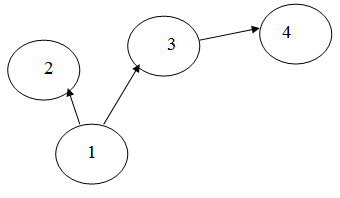
Fig. 1
The fourth meaning ‘to be impassioned’ as a chain connection with the third conceptem.
But unfortunately, both in the ‘Azerbaijani – Russian dictionary’ (2006) and in the ‘Explanatory dictionary of the Azerbaijani language’ (2006) these lexems are given in the same form – the first and the second meanings are homonyms, but the third and fourth ones are given as polysems of the first meaning.
The principles of presentation of homonyms in dictionaries with both common or uncommon vocabulary must be determined according to the same rules in the whole vocabulary of the dictionary. But some problems arising during the research make one look through these principles again. It is known that the uncommon vocabulary can be given in the paradigmatic row of homonyms, for example:
Eşmək1 verb. 1. to dig, to dig up. 2. to twist. To twirl one’s moustache. 3. to bind, to tie... 4. to weave. To lay rope. 5. metaph. To fumble (in, about), to look for, to search (somebody) ...
Eşmək2 noun. Women’s sleeveless jacket or cardigan.
But the differentiation of homonyms isn’t reflected in the dictionaries in the same form at all. The principles of homonymy haven’t been determined unequivocally in Azerbaijani linguistics, so it causes incoincidence and disputable graphic solution of the word that is incorrect from the standpoint of lexicography. For example, all the meanings of the lexem birəlli ‘one-armed’ are given as widely used words in the ‘Explanatory dictionary of the Azerbaijani language’ (2006):
Birəlli1 1. adj. One-armed, with only one hand. One-armed man; to be one-armed. 2. adv. To do something with one hand. To pick berries with one hand. Birəlli tutmaq “to keep with one hand” – to attach no importance to something, not to take (somebody, something) into consideration, not to appreciate somebody. Yoldaşını birəlli tutmaq – not to appreciate a friend.
Birəlli2 noun. Container with one handle.
Lexical homonyms are to be related to the same part of speech, but the meanings of the lexem birəlli are expressed by three parts of speech and there is associative connection between them formed as a result of metaphorical meaning on the semantic level. Hence its meanings are homonyms and they are to be given within the same dictionary entry. That is why birəlli1 and birəlli2 are neither lexical nor lexical-grammatical homonyms because they belong to the different parts of speech as it is given in the ‘Explanatory dictionary of the Azerbaijani language’ (2006).
The associative connection between all meanings of the lexem birəlli and their belonging to the different parts of speech make it possible to regard them as grammatical homonyms.
In the ‘Azerbaijani-Russian dictionary’ (2006), unlike the explanatory dictionary this word is expressed as an adjective and a noun and divided into two grammatical homonyms with two Roman numerals, but its adverb meaning isn’t taken into consideration. The first grammatical homonym that means an adjective is given with two polysemantic meanings marked by Arabic numerals:
Birəlli I adj. 1. One-armed. 2. With one handle. t e ch n. One-armed boring.; II. noun. dialect. A big copper mug.
Though the second grammatical homonyms given as a dialectal word, actually it is to be regarded as an archaism.
The vocabulary entry of the lexem birəlli is supposed to be the following:
Birəlli I adj. 1. One-armed; With one hand. One-armed man. To be one-armed. 2. techn. One-armed boring. II. adverb. Only with one hand. To pick berries with one hand. ◊ Birəlli tutmaq (to keep with one hand) – to attach no importance to something, not to take (somebody, something) into consideration, not to appreciate somebody. Yoldaşını birəlli tutmaq – not to appteciate a friend. III. noun. obsolete. A container with one handle. Fill this container with one handle with water.
Being included in the polisemantic differential row of the grammatical homonym I, the terminological combination one-armed boring forms a separate radial. We consider the substantivated archaic word birəlli (container for water) that isn’t a widely used word formed from the epidigmatic connection with meaning I as a grammatical homonym III. The semantic structure of this lexem has the following radial form.
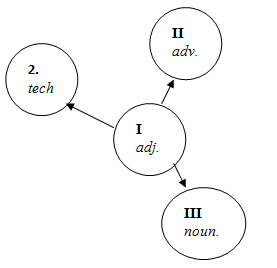
Fig. 2
As a result of the research it is known that among the Azerbaijani philological dictionaries only the ‘Azerbaijani-Russian dictionary’ (2006) gives more correct determination of the homonym paradigm. At the same time in the above-mentioned dictionary the principle of the ‘grammatical homonyms’ contradicts the grammar rules of the Azerbaijani language.
In the ‘Explanatory dictionary of the Azerbaijani language’ (2006) the meanings of the lexem qaynaq are systematized by the following way:
QAYNAQ1 noun. spring; source.
QAYNAQ2 noun. techn. 1. Welding. 2. Soldered joint (in metals)
QAYNAQ3 noun. 1. Claw. What a bird it was! Its claw like a sharp knife sheds blood. (Khasta Qasim). 2. metaph. Hand, paw. Claw.
There is an epidigmatic connection between the widely used word qaynaq1 and technical term qaynaq2, that is formed from the verb ‘qaynamaq’ (to boil, to seethe). There is a metaphorical meaning of the verb ‘qaynamaq’ (to boil, to seethe) in the first one, that is to say it is an associative connection, but the second one has an ethymological meaning dealt with smelting of metals. It is a matter of process of boiling. Naturally their semantems aren’t homonyms, they must be included in the polysemantic paradigm. But as qaynaq3 has no epidigmatic connection with the verb “qaynamaq” (to boil, to seethe) and no ethimological and associative connection with qaynaq1 and qaynaq2 can’t be included in homonym paradigm. Though it’s given as a widely used word, actually it must be marked as an obsolete word.
It is possible to construct the hierarchy of semantic relations.
Table 1
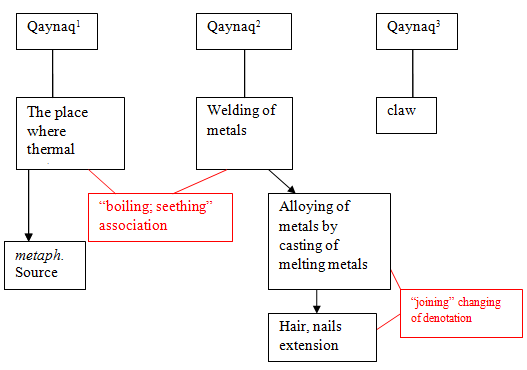
Here the word qaynaq3 (claw) not forming the epidigmatic connection with the verb ‘qaynamaq’ (to boil; to seethe) and not having the etymological and associative connection with the words qaynaq1 (source) and qaynaq2 (welding of metals) is automatically included in homonymy paradigm. Though it is given as a widely used word, actually it is marked with a stylistic sign ‘archaic’. There is an epidigmatic connection between the widely used word qaynaq1 and the technical term qaynaq2 that originates in the verb qaynamaq (to boil; to sneethe).
If there is a metaphoric meaning of the verb qaynamaq in the first one, i.e. there is an associative connection, the second one actually has the etymological meaning connected with melt of metals. Both of them means the process of boiling. Naturally, their semantemes should be included not in the homonymous paradigm but in ‘the heterogeneous polysemantic paradigm’ (Vinogradov 1952: 206). Though after the sememe ‘welding of metals’ as a result of the historical-semantic development the denotation changed and transformed from ‘boiling’ to ‘joining; fastening’, such expressions as ‘qaynaq dırnaq’ (accrued nailes), ‘qaynaq saç’ (hair extension) create the association ‘welding of metals’ again.
Thus the meanings of the lexem qaynaq can be systematized from the lexicographical standpoint by the following way:
QAYNAQ1 noun. 1. Source. The place where thermal waters boil and come out. 2. metaph. Spring. 3. techn. 1) Welding. 2) Soldered joint (in metals). 3) To join, to fasten. Qaynaq dırnaq – nail extension, qaynaq saç – hair extension, qaynaq etmək – to extend, qaynaq etdirmək – to have nails or hair extended.
QAYNAQ2 noun. obsolute. 1. Claw. What a bird it was! Its claw like a sharp knife sheds blood. (Khasta Qasim). 2. metaph. Hand, paw. Claw.
From the standpoint of determination of connections between the semantems of polysemantic word there is a radial connection between the semantems of the word qaynaq1 marked by the Arabic numerals with bracket, so there is a chain semantic connection between them.
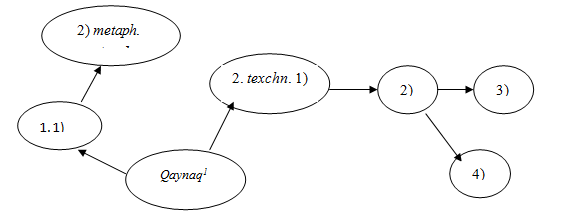
Fig. 3
The concept ‘welding, soldered joint (in metals)’ has ungergone the semantic broadening and now it is used in the art of beauty as ‘nail or hair extention’.
Most scientists may consider it to be homonym. But it’s clear that nail or hair extention becomes similar to welding as a result of associative connection and thus the word qaynaq is used by this way. So we include this meaning in the polysemantic paradigm.
Unlike the aforesaid lexem the word qısqac is correctly determined and explained in the ‘Explanatory dictionary of the Azerbaijani language’ (2006). This word is used both as a zoological and technical term:
Qısqac noun. 1. zool. Earwig – a small sized insect that has sharp pincers on its abdomen and large wings that generally remain concealed against its body. Earwigs are nocturnal insects that hide in small, moist crevices during the day and are active in night. 2. zool. An insect with small horns on its head that look like scissors. 3. chela; pincers. 4. special. Clamp; clutch; clim.
The semantems of this lexem have polysemantic-radial relations as a result of the associative connection.
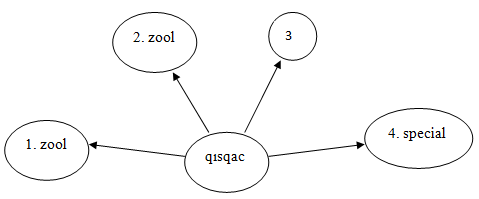
Fig. 4
Thus when compiling explanatory and translation dictionaries a lexicographer must determine polysemantic relations correctly and must be not only very competent but also very serious and responsible.
Approaching the fact of ‘the breaking of the motivation between the meanings of the words’ may puzzle the scientists. This principle must be rejected unequivocally. While determining homonymy two main principles must be given into consideration: associative and etymological ones. Only by this way, it will be possible to draw an exact boundary between homonymy and polysemy.
Thus when tracing intercommunication of semantic relations that develop in the chain or radial form, a lexicographer who creates its hierarchical dictionary entry in the case of accepting of the hypothesis ‘homonym can be formed as a result of removal of meaning’ breaks off this semantic development. From this standpoint, the whole presentation of epidigmatics of each lexeme in dictionaries enables the readers to trace its semantic hierarchy. On the other hand, such approach will be observed by the determination of homonyms in the same form in all the dictionaries.
Литература
- Abayev, V.I. 1957. О подаче омонимов в словарях // Вопросы языкознания.- -С.31-43. (In the Russian language).
- Alekberli A. 1985. Feillərin leksik-semantik xüsusiyyətləri. Müasir Azərbaycan dilinin semasiologiyası (oçerklər). Redaktoru Z.Budaqova. – Bakı: Elm,– 244 p. (In the Azerbaijani language).
- Aslanov, V. 2013. The collection of Azerbaijani linguistics. (Azərbaycan dilçiliyi müntəxabatı). Volume III. The history of Azerbaijani linguistics: from the XX century to the present. Baku, 521 p. (In the Azerbaijani language).
- Azerbaijani-Russian dictionary. (Azərbaycanca-rusca lüğət). 2006. Dörd cilddə. Bakı, “Şərq-Qərb”.
- Bally, Ch. 1921. Traite de stylistique françise. Premier volume. Seconde edition. Heidelberg, 331 p.
- Eventhough, N. and Sanelisiwe, S. 2010. The Treatment of Polysemy and Homonymy in Monolingual General-purpose Dictionaries with Special Reference to Isichazamazwi SesiNdebele. Lexikos 20 (AFRILEX-reeks/series 20:2010): 351-370.
- Explanatory dictionary of the Azerbaijani language. 2006. (Azərbaycan dilinin izahlı lüğəti). Dörd cilddə. Bakı, “Şərq-Qərb”.
- Jafarov, S. 1960, 2008. Azərbaycan dilində söz yaradıcılığı. Bakı. (In the Azerbaijani language).
- Həsənov H. Azərbaycan dilinin omonimlər lüğəti. Bakı, “Şərq-Qərb”, 2007, 168 p. (In the Azerbaijani language).
- Lyons, J. 1977. Semantics. Volumes 1 and 2. Cambridge: Cambridge University Press.
- Mammedov, İ. 1985. Azərbaycan dilinin semantikası. Bakı: Xəzər nəşriyyatı, 2006. – 372 p. (In the Azerbaijani language).
- Moiseyeva, S.A. 2010. Лексико-семантическая парадигма глаголов восприятия в новороманских языках. (In the Russian language). С. А. Моисеева // Каразiнскi читання: людина. Мова. Коммуникацiя : матерiали IX мiжнар. наук. конф., Харькiв, 5 лютого 2010 р. / ХНУ ; вiдп. за вип. В.Г. Пасинок. – Харькiв,– С. 205-208.
- Mojela, V.M. Polysemy and Homonymy: Challenges Relating to Lexical Entries in the Sesotho sa Leboa–English Bilingual Dictionary. Lexikos 17 (AFRILEX-reeks/series 17: 2007): 433-439.
- Tagiyeva, Z. 1963. Azərbaycan SSR EA Xəbərləri. Ictimai elmlər seriyası. №4. (In the Azerbaijani language).
- Taylor, J.R. 1989. Linguistic Categorization: Prototypes in Linguistic Theory. Oxford: Clarendon Press.
- Vinogradov, V.V. 1952. Словообразование и его отношение к грамматике и лексикологии (на материале русского и родственных языков) // Вопросы теории и истории языка. М., p. 99-152. (In the Russian language).
- Xəlilov, B. 2008. Müasir Azərbaycan dilinin leksikologiyası: leksikologiya, semasiologiya, etimologiya, onomalogiya, frazeologiya, leksikoqrafiya, sözyaradıcılığı [Dərslik] /Buludxan Xəlilov; Elmi red. A.Ə.Bayramov; Rəyçilər. H.I.Mirzəyev, H.B.Balıyev.- Bakı: Nurlan, - 444 p. (In the Azerbaijani language).
References
- Abayev, V.I. 1957. O podache omonimov v slovarjah // Voprosy jazykoznanija.- -S.31-43. (In the Russian language).
- Alekberli A. 1985. Feillərin leksik-semantik xüsusiyyətləri. Müasir Azərbaycan dilinin semasiologiyası (oçerklər). Redaktoru Z.Budaqova. – Bakı: Elm,– 244 p. (In the Azerbaijani language).
- Aslanov, V. 2013. The collection of Azerbaijani linguistics. (Azərbaycan dilçiliyi müntəxabatı). Volume III. The history of Azerbaijani linguistics: from the XX century to the present. Baku, 521 p. (In the Azerbaijani language).
- Azerbaijani-Russian dictionary. (Azərbaycanca-rusca lüğət). 2006. Dörd cilddə. Bakı, “Şərq-Qərb”.
- Bally, Ch. 1921. Traite de stylistique françise. Premier volume. Seconde edition. Heidelberg, 331 p.
- Eventhough, N. and Sanelisiwe, S. 2010. The Treatment of Polysemy and Homonymy in Monolingual General-purpose Dictionaries with Special Reference to Isichazamazwi SesiNdebele. Lexikos 20 (AFRILEX-reeks/series 20:2010): 351-370.
- Explanatory dictionary of the Azerbaijani language. 2006. (Azərbaycan dilinin izahlı lüğəti). Dörd cilddə. Bakı, “Şərq-Qərb”.
- Jafarov, S. 1960, 2008. Azərbaycan dilində söz yaradıcılığı. Bakı. (In the Azerbaijani language).
- Həsənov H. Azərbaycan dilinin omonimlər lüğəti. Bakı, “Şərq-Qərb”, 2007, 168 p. (In the Azerbaijani language).
- Lyons, J. 1977. Semantics. Volumes 1 and 2. Cambridge: Cambridge University Press.
- Mammedov, İ. 1985. Azərbaycan dilinin semantikası. Bakı: Xəzər nəşriyyatı, 2006. – 372 p. (In the Azerbaijani language).
- Moiseyeva, S.A. 2010. Leksiko-semanticheskaja paradigma glagolov vosprijatija v novoromanskih jazykah. (In the Russian language). S. A. Moiseeva // Karazinski chitannja: ljudina. Mova. Kommunikacija : materiali IX mizhnar. nauk. konf., Har'kiv, 5 ljutogo 2010 r. / HNU ; vidp. za vip. V.G. Pasinok. – Har'kiv,– S. 205-208.
- Mojela, V.M. Polysemy and Homonymy: Challenges Relating to Lexical Entries in the Sesotho sa Leboa–English Bilingual Dictionary. Lexikos 17 (AFRILEX-reeks/series 17: 2007): 433-439.
- Tagiyeva, Z. 1963. Azərbaycan SSR EA Xəbərləri. Ictimai elmlər seriyası. №4. (In the Azerbaijani language).
- Taylor, J.R. 1989. Linguistic Categorization: Prototypes in Linguistic Theory. Oxford: Clarendon Press.
- Vinogradov, V.V. 1952. Slovoobrazovanie i ego otnoshenie k grammatike i leksikologii (na materiale russkogo i rodstvennyh jazykov) // Voprosy teorii i istorii jazyka. M., p. 99-152. (In the Russian language).
- Xəlilov, B. 2008. Müasir Azərbaycan dilinin leksikologiyası: leksikologiya, semasiologiya, etimologiya, onomalogiya, frazeologiya, leksikoqrafiya, sözyaradıcılığı [Dərslik] /Buludxan Xəlilov; Elmi red. A.Ə.Bayramov; Rəyçilər. H.I.Mirzəyev, H.B.Balıyev.- Bakı: Nurlan, - 444 p. (In the Azerbaijani language).
